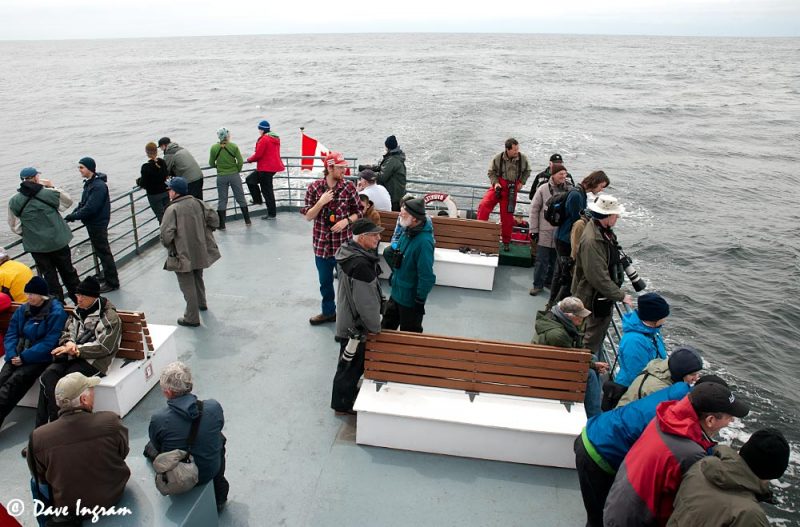Despite a painfully stiff back (which I threw on Thursday wrestling with the kids), I made the trek to Ucluelet in order to join the April 29, 2012 WildResearch pelagic trip out to La Pérouse Bank. At the end of the day, this 7 hour off shore tour was nothing short of “shear” birding and wildlife viewing fun—not only were the birds spectacular, we also got some great looks at killer whales, humpback whales, gray whales, and even a pair of sea otters.
This is a tour that is very different from typical short whale watching type tours. WildResearch charters the 128′ MV Francis Barkley, a vessel that does a regular run from Port Alberni through the Broken Group Island to Ucluelet and Bamfield during the summer months. The large size of the boat and three outside deck levels make it an excellent platform for sea bird and wildlife viewing. It also makes it a fairly comfortable vessel in the potentially rough 40 kilometers of open ocean between Ucluelet and La Pérouse Bank.

At 6:30 am birders in full wet weather gear were gathering on the main dock in Ucluelet in the gray morning drizzle to board the Francis Barkley. The weather didn’t look promising but the forecast was for clearing later in the day and by the time we left the harbour the wet mist had already started to break.
Sightings of common murres were common on the way out and soon our first sooty shearwaters (Puffinus griseus) made an appearance. These were by far the most common shearwaters of the day and easy to identify even at a distance by their “sooty brown” colour and the flash of the silvery under wings as they banked and soared over the long slow waves.

Mixed in with the more common “sooties” was the occasional pink-footed shearwater (Puffinus creatopus)—definitely fewer in numbers and generally on solitary birds were seen. Unfortunately, I missed a flock of short-tailed storm-petrels (Oceanodroma furcata) when I went into the cabin to get my camera gear. I did get some nice looks at mixed flocks of Sabine’s gulls (Xema sabini) and Bonaparte’s gulls (Larus philadelphia).

At La Pérouse the ship slowed and the “chumming” began. Fish offal from the processing plants in Ucluelet were thrown over the side to attract gulls and the black-footed albatross (Phoebastria nigripes).

The albatrosses made an already excellent trip spectacular and everyone on the boat was able to get great looks at these beautiful ocean wanderers as they came in close to feed.

Listers were able to add Manx shearwater (Puffinus puffinus) to their British Columbia lists—a single bird was seen on the way out and on the way back in. This was only the 22nd record of Manx shearwater in the province so it was definitely a highlight of the trip!

In every way this was an amazing trip. The birding was good (numbers and variety are supposed to be better in the fall) and the size of the boat made the long exposed trip very comfortable for most people. About a half dozen or so of the 86 passengers were sea sick, but the majority found their sea legs and had no problems with the swell. The bonus was that not only did we get to see birds that most people never see, the marine mammal viewing was excellent as well. Reservations haven’t opened for the fall 2013 trip but I’ll definitely be signing up for that tour when it is announced!

Need to Know:
- Cost: $200/person plus $25 membership with WildResearch (early registration)—compare that to the cost of a typical 3 hour whale watching tour and you know you’re getting excellent value for your money!
- Gravol is recommended. I actually didn’t take any beforehand, but ran into a couple of Comox Valley birders who had gravol with them. I felt a little queasy and probably could have done without the gravol but took one when offered. One birder was so sick that he spent most of the trip vomiting over the back of the boat or curled up in the fetal position on the deck. Most seemed OK.
- Warm wet weather gear is essential – I had on full rain gear plus layers of long underwear on underneath. By the late afternoon when the sun made an appearance I was able to take off some of the layers but it was nice being warm and dry in the morning.
- While the focus is birds, you’ll likely get great looks a marine mammals as well. Many top British Columbia birders like Russell Cannings, Tom Plath and Jeremiah Kennedy were on board so you’ve got some excellent professional guides to help you out.
- Binoculars definitely recommended. Photographers will need a long lens to pull in the shearwaters but some birds will approach the boat closely enough for good photographs. I rented a Nikon 200-400mm and used it on my DX camera but still was unsatisfied with the reach. The larger heavier lens might have been a bit of a disadvantage because I had to handhold it and the birds were moving fairly quickly. Fellow Comox Valley birder, Terry Thormin was able to get excellent photographs using a Panasonic Lumix G3 with a 100 to 300 mm zoom lens!